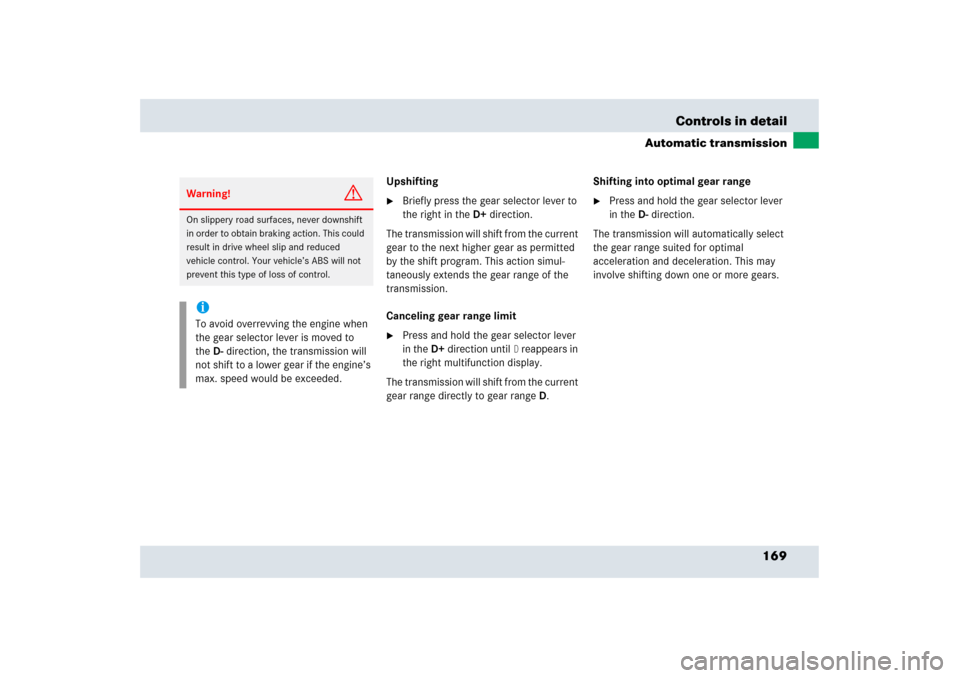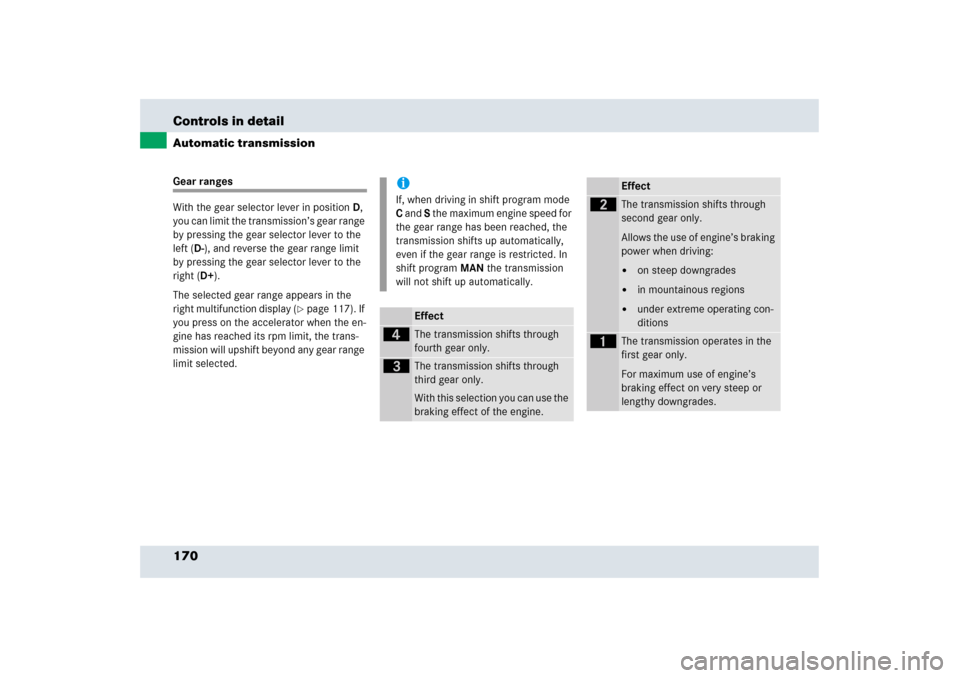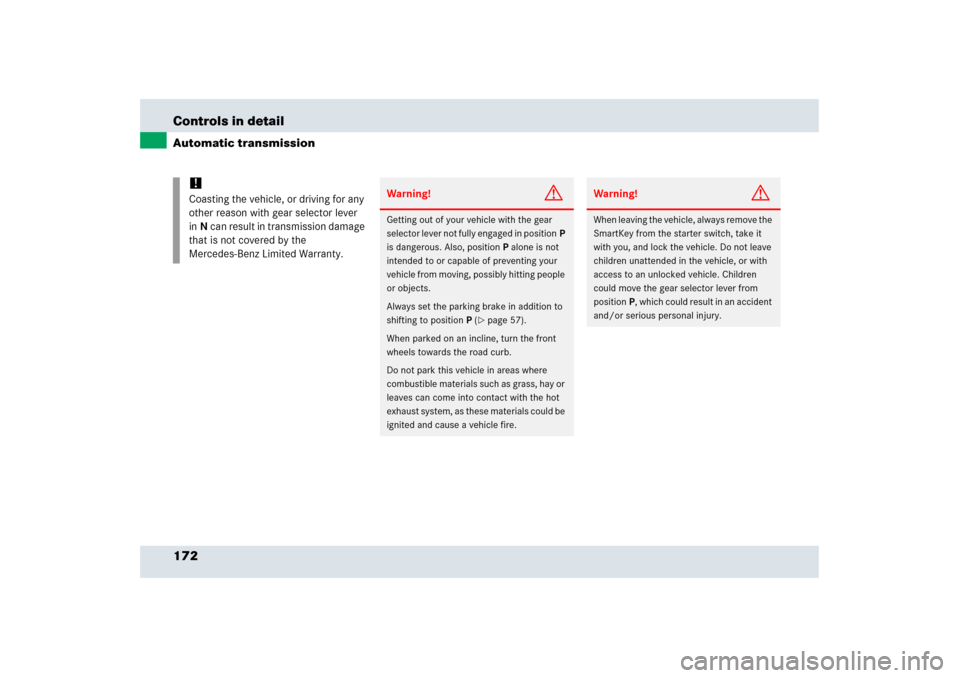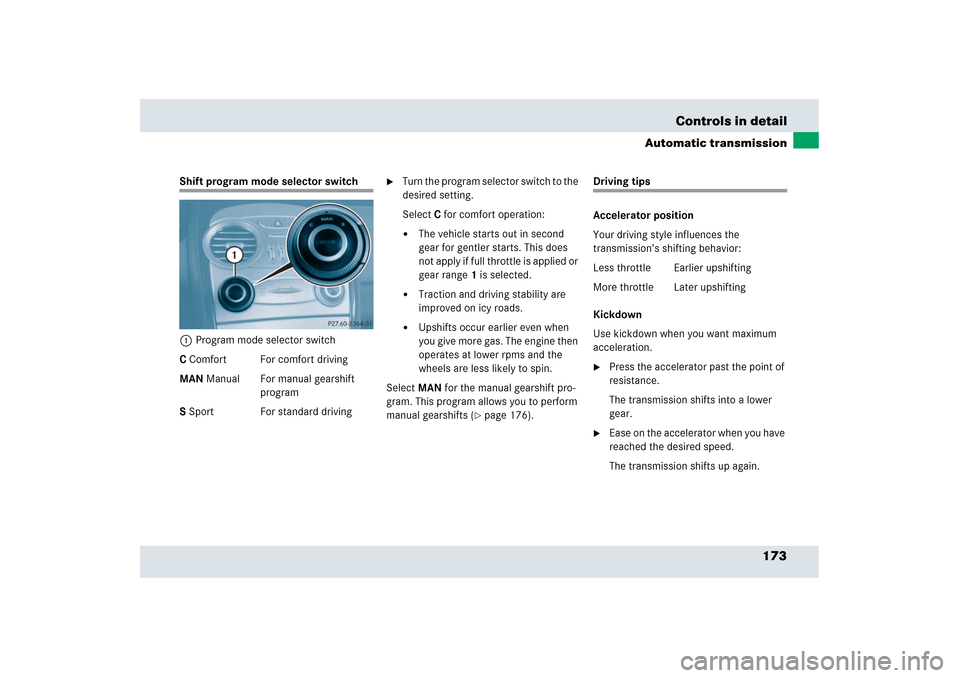Page 123 of 409

122 Controls in detailControl system
Standard display menu
The left display field shows the outside
temperature and main odometer, while the
trip odometer and the clock appears in the
right display field. This is the standard dis-
play.
Standard display1Main odometer
2Outside temperature
3Current gear selector lever posi-
tion/gear range
4Trip odometer
5Automatic transmission shift program
mode
6Clock�
If you see another display, press
buttonè orÿ repeatedly until
the standard display appears.
�
Press buttonk orj to select
the functions in the standard display
menu.
iThe headings used in the menus table
are designed to facilitate navigation
within the system and are not
necessarily identical to those shown in
the control system displays.
The first function displayed in each
menu will automatically show you
which part of the system you are in.
iYou can have the outside temperature
displayed instead of the digital
speedometer. You can select the
setting in the submenu
Inst. cluster
via the function
Select display
(
�page 130).
Page 168 of 409

167 Controls in detail
Automatic transmission
�Automatic transmission
For information on driving with an auto-
matic transmission, see the “Getting
started” section (
�page 49).
Your vehicle’s transmission adapts its gear
shifting process to your individual driving
style by continually adjusting the shift
points up or down. These shift point adjust-
ments are performed based on current
operating and driving conditions.
If the operating conditions change, the
automatic transmission reacts by
adjusting its gear shift program.
Gearshift patternThe automatic transmission selects indi-
vidual gears automatically, depending on:�
the gear selector lever position D with
gear ranges 4, 3, 2 and 1 (
�page 170)
�
the selected shift program mode
(C/MAN/S)(
�page 173)
�
the position of the accelerator pedal
(�page 173)
�
the vehicle speed
The current gear selector lever position
(
P/R/N/D), the gear range (
1/2/3/4) and
the shift program (
C/M/S) are shown in the
standard display (
�page 117).
iDuring the brief warm-up, transmission
upshifting is delayed. This allows the
catalytic converter to heat up more
quickly to operating temperature.
!Allow engine to warm up under low
load use. Do not place full load on the
engine until the operating temperature
has been reached (
�page 303).
Shift into park position P or reverse
gearR only when the vehicle is
stopped.
Avoid spinning of a drive wheel for an
extended period when driving off on
slippery road surfaces. This may cause
serious damage to the drivetrain which
is not covered by the Mercedes-Benz
Limited Warranty.
Page 169 of 409

168 Controls in detailAutomatic transmissionAn additional indication of the current gear
selector lever position can be found on the
cover of the shifting-gate.When the gear selector lever is in
positionD, you can influence transmission
shifting by
�
limiting the shift range
�
changing gears manually
One-touch gearshifting
Even with an automatic transmission you
can change the gears manually when the
gear selector lever is in positionD.
Downshifting�
Briefly press the gear selector lever to
the left in theD-direction.
The transmission will shift from the cur-
rent gear to the next lower gear. This
action simultaneously limits the gear
range of the transmission
(�page 170).
Warning!
G
It is dangerous to shift the gear selector
lever out ofP orN if the engine speed is
higher than idle speed. If your foot is not
firmly on the brake pedal, the vehicle could
accelerate quickly forward or reverse. You
could lose control of the vehicle and hit
someone or something. Only shift into gear
when the engine is idling normally and when
your right foot is firmly on the brake pedal.
Page 170 of 409

169 Controls in detail
Automatic transmission
Upshifting�
Briefly press the gear selector lever to
the right in theD+direction.
The transmission will shift from the current
gear to the next higher gear as permitted
by the shift program. This action simul-
taneously extends the gear range of the
transmission.
Canceling gear range limit
�
Press and hold the gear selector lever
in theD+direction until
D reappears in
the right multifunction display.
The transmission will shift from the current
gear range directly to gear rangeD.Shifting into optimal gear range
�
Press and hold the gear selector lever
in theD-direction.
The transmission will automatically select
the gear range suited for optimal
acceleration and deceleration. This may
involve shifting down one or more gears.
Warning!
G
On slippery road surfaces, never downshift
in order to obtain braking action. This could
result in drive wheel slip and reduced
vehicle control. Your vehicle’s ABS will not
prevent this type of loss of control.iTo avoid overrevving the engine when
the gear selector lever is moved to
theD-direction, the transmission will
not shift to a lower gear if the engine’s
max. speed would be exceeded.
Page 171 of 409

170 Controls in detailAutomatic transmissionGear ranges
With the gear selector lever in positionD,
you can limit the transmission’s gear range
by pressing the gear selector lever to the
left (D-), and reverse the gear range limit
by pressing the gear selector lever to the
right (D+).
The selected gear range appears in the
right multifunction display (
�page 117). If
you press on the accelerator when the en-
gine has reached its rpm limit, the trans-
mission will upshift beyond any gear range
limit selected.
iIf, when driving in shift program mode
C and S the maximum engine speed for
the gear range has been reached, the
transmission shifts up automatically,
even if the gear range is restricted. In
shift program MAN the transmission
will not shift up automatically.
Effect
é
The transmission shifts through
fourth gear only.
è
The transmission shifts through
third gear only.With this selection you can use the
braking effect of the engine.
Effect
ç
The transmission shifts through
second gear only.
Allows the use of engine’s braking
power when driving:�
on steep downgrades
�
in mountainous regions
�
under extreme operating con-
ditions
æ
The transmission operates in the
first gear only.
For maximum use of engine’s
braking effect on very steep or
lengthy downgrades.
Page 172 of 409

171 Controls in detail
Automatic transmission
Gear selector lever positions
Effect
ì
Park position
Gear selector lever position
when the vehicle is parked. Place
gear selector lever in positionP
only when vehicle is stopped.
The park position is not intended
to serve as a brake when the
vehicle is parked. Rather, the
driver should always set the
parking brake in addition to
placing the gear selector lever in
positionP to secure the vehicle.
EffectThe SmartKey can only be
removed from the starter switch
with the gear selector lever in
positionP. With the SmartKey
removed, the gear selector lever
is locked in positionP.
If the vehicle’s electrical system
is malfunctioning, the gear
selector lever could remain
locked in positionP.
í
Reverse gear
Place gear selector lever in
positionR only when vehicle is
stopped.
Effect
ë
Neutral
No power is transmitted from the
engine to the drive axle. When
the brakes are released, the
vehicle can be moved freely
(pushed or towed).
To avoid damage to the trans-
mission, never engageN while
driving.
If the ESP
® is deactivated or
malfunctioning:
Move gear selector lever toN
only if the vehicle is in danger of
skidding, e.g. on icy roads.
ê
Drive
The transmission shifts
automatically. All five forward
gears are available.
Page 173 of 409

172 Controls in detailAutomatic transmission
!
Coasting the vehicle, or driving for any
other reason with gear selector lever
inN can result in transmission damage
that is not covered by the
Mercedes-Benz Limited Warranty.
Warning!
G
Getting out of your vehicle with the gear
selector lever not fully engaged in positionP
is dangerous. Also, positionP alone is not
intended to or capable of preventing your
vehicle from moving, possibly hitting people
or objects.
Always set the parking brake in addition to
shifting to positionP (
�page 57).
When parked on an incline, turn the front
wheels towards the road curb.
Do not park this vehicle in areas where
combustible materials such as grass, hay or
leaves can come into contact with the hot
exhaust system, as these materials could be
ignited and cause a vehicle fire.
Warning!
G
When leaving the vehicle, always remove the
SmartKey from the starter switch, take it
with you, and lock the vehicle. Do not leave
children unattended in the vehicle, or with
access to an unlocked vehicle. Children
could move the gear selector lever from
positionP, which could result in an accident
and/or serious personal injury.
Page 174 of 409

173 Controls in detail
Automatic transmission
Shift program mode selector switch
1Program mode selector switch
C Comfort For comfort driving
MAN Manual For manual gearshift
program
S Sport For standard driving
�
Turn the program selector switch to the
desired setting.
Select C for comfort operation:�
The vehicle starts out in second
gear for gentler starts. This does
not apply if full throttle is applied or
gear range1 is selected.
�
Traction and driving stability are
improved on icy roads.
�
Upshifts occur earlier even when
you give more gas. The engine then
operates at lower rpms and the
wheels are less likely to spin.
Select MAN for the manual gearshift pro-
gram. This program allows you to perform
manual gearshifts (
�page 176).
Driving tips
Accelerator position
Your driving style influences the
transmission’s shifting behavior:
Less throttle Earlier upshifting
More throttle Later upshifting
Kickdown
Use kickdown when you want maximum
acceleration.�
Press the accelerator past the point of
resistance.
The transmission shifts into a lower
gear.
�
Ease on the accelerator when you have
reached the desired speed.
The transmission shifts up again.